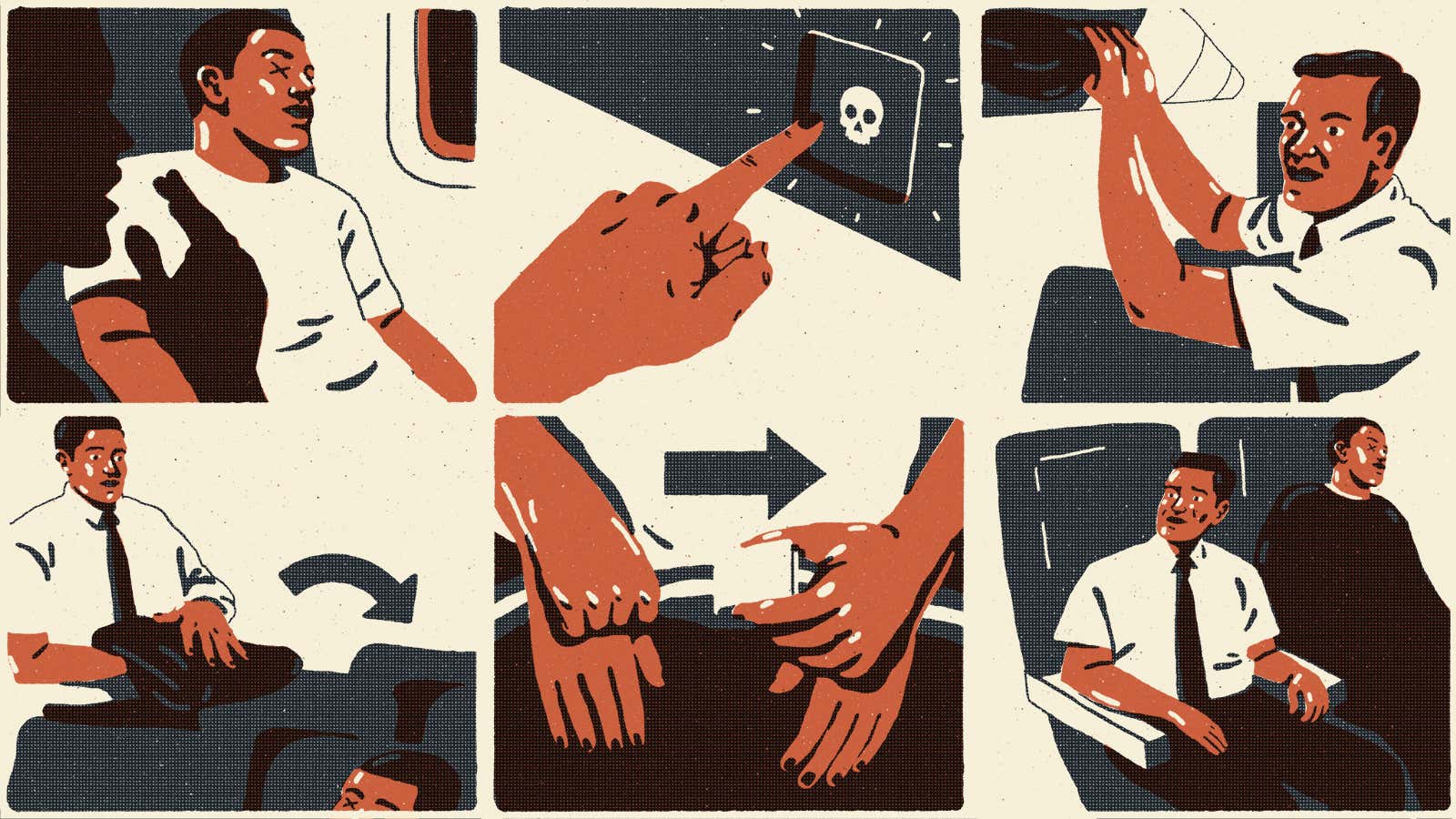People who die on airplanes aren’t dead. Not legally, anyway.
In the unlikely event that a passenger expires mid-flight, he or she generally cannot be legally pronounced dead until a doctor or other local authority on the ground has had a chance to look. But the truth is, passengers do die on airplanes from time to time, leaving crew to deal with an unexpected and uncomfortable situation.
Several airlines told Quartz they don’t have a hard and fast rule for what to do if a passenger dies on board. It depends on cabin space and the state of the passenger.
But Singapore Airlines does have a set of procedures. (A passenger died on one of its flights from New Delhi to Singapore in January. It also operates some of the longest flights around and is again vying for the crown for the longest of long-hauls, so the issue was bound to come up.)
“The deceased will be moved to an empty row of seats and covered in a dignified manner,” a spokesman for Singapore Airlines tells Quartz. “If no seats are available, the body will be left in the deceased’s existing seat. Customers seated next to the deceased will be moved to other available seats wherever this is possible.”
An Airbus A340 that Singapore Airlines used to operate for long-haul flights had a special compartment where a dead passenger could be placed and buckled in if no row of empty seats been available, the Guardian reported in 2004.
It came to be known as the “corpse cupboard”—though the airline spokesman told Bloomberg News three years ago that the compartment hadn’t ever been used for that purpose as the planes were being taken out of service. Other airlines are more… flexible with how they handle the situation.
“You cannot put a dead passenger in the toilet,” says an instructor who was filmed training British Airways flight attendants in the BBC documentary “A Very British Airline.”
“It’s not respectful and also they are not strapped in for landing,” she adds. “If they slid off the toilet, which could easily happen when you land, they would end up on the floor and they’d have to take the aircraft apart to get that person out.” (Airplane bathroom doors usually fold inwards when opened.)
“It’s a very gray subject, isn’t it, because it’s on the day,” says the BA instructor in the documentary.
It’s also something that most airlines don’t want to talk about. Of the airlines to which Quartz reached out, Qantas, LATAM, Air France-KLM, Avianca, Japan Airlines, Etihad and Cathay Pacific either declined to comment or didn’t respond to requests for comment on their procedures in the event of a death on board.
Prepare for landing
So just how frequently does it occur? Statistics on how frequently passengers die on board are hard to come by. Though a study published in the New England Journal of Medicine in 2013 (pdf) reviewed 11,900 in-flight emergencies from 2008 to 2010 from five airlines and found that 36 of the cases resulted in the death of a passenger—or 0.3%. Thirty of them died during the flight.
The 2013 study found only 7.3% of flights were diverted for a medical emergency.
The case of a medical emergency is about one in every 600 flights. Heart and breathing complications are the most common severe emergencies, says T.J. Doyle, medical director at Stat-MD, a medical communications service for airlines at the University of Pittsburgh Medical Center.
There is also no set rule about diverting the flight for a sick passenger. Pilots ultimately decide whether a divert due to a medical emergency, partly based on the guidance of on-the-ground medical advice the crew is applying to the passenger.
For the unlucky passenger who doesn’t make it to the ground, a death may even go unnoticed by fellow passengers. Though rigor mortis—the stiffening of muscles after death due to lack of oxygen—and livor mortis—a pooling of the blood in the lower part of the body—can set in within 30 minutes, the stiffness and discoloration may not be apparent if the person is seated or has a blanket on his or her lap.
“They’re only up there for an hour or two and even on a long international flight, it’s not like they’re going to turn into a puddle or something like out of a horror movie,” Doyle said. Paulo Alves, global medical director at MedAire, another medical emergency call center for major airlines, notes that passengers at altitude may be more bloated. “Gas that’s trapped in body cavities can expand, to a rate of 25%,” he says.
One issue that could be more unpleasant for fellow passengers is the deceased’s release of bodily fluids, the result of no muscle control. But putrefaction—the decaying of the body—generally won’t happen for about 20 hours.
The International Air Transport Association, the trade group that represents most of the world’s airlines, advises that the flight crew should move the deceased passenger to a seat with few fellow travelers nearby, and “be aware of the difficulty of the situation for companions and onlookers.” Other options include placing them in the galley or moving the passenger to first class.
Though perhaps passengers that are paying more than $10,000 for a seat would prefer not to sit next to a corpse. (Which is probably still better than flying economy.)
